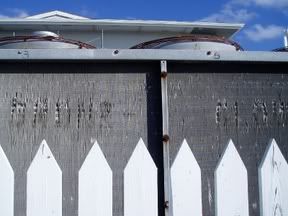ChasBean1 (Mechanical) 13 Oct 06 14:26
A couple links:
6 m/s velocity at an intake louver is more than twice what I would want to see. At an exhaust louver it may not be so bad.
Those are my favourite manufacturers chas, the most common louver I use is Ruskin's EME6625D, it is Dade County approved for 'large misslie impact' and it somewhat resistant to wind driven rain, but if there is a hurricane all bets are off, it becomes blowing steam and a lot of water gets through.
The ruskin submittal is
and it shows the free areas of the various louver sizes as well as the pressure drop based on the velocity through the free area. The larger louvers are about 42% free area, the smaller ones less than say 24x24 are much more restrictive as the back side is braced with angles to strengthen it up for passing the missile impact test. A 12x12 louver will have an open slot on the back that is about 8"x2" and that is the free area.
Just trying to emphasize to the Original Poster that it is important to verify how louvers are rated, and to look at the free area of the louver and not just a face velocity. The free area velocity will be a lot higher than the face velocity.
Greenheck makes a vertical blade louver that is more resistant to wind driven moisture than the EME 6625D however to the best of my knowledge it is not certified to the large missile impact test I need down here.
The test is to with stand three consecutive hits of a 2x4 at 35 mph. I always hear the rumour that at 55 mph, a 2x4 will penetrate concrete block.
Greenheck is a first class company in my opinion and if the local representative ever offers you a factory tour in Wisconsin, it is well worth the trip. I found their kitchen ventilation demonstration to be quite informative.
Take the "V" out of HVAC and you are left with a HAC(k) job.

